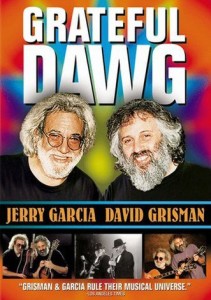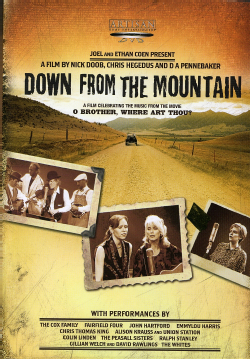 When I received a DVD player for my 50th birthday last August, my two sons had visions of using it to watch crystal clear wide-screen versions of Jackie Chan and Jean-Claude van Damme movies. Not when I’m around! Well, once in awhile we’ll rent an action flick for Friday night, but the real value of the DVD player is in viewing an ever increasing number of music films. These films seek to provide an intimate, and high quality, look at the music and musicians we have until now known only by their recordings, and irregular tours. My own lack of success in getting front row seats for these tours means that the close-up views provided by videos brings a new perspective to their life and work.
When I received a DVD player for my 50th birthday last August, my two sons had visions of using it to watch crystal clear wide-screen versions of Jackie Chan and Jean-Claude van Damme movies. Not when I’m around! Well, once in awhile we’ll rent an action flick for Friday night, but the real value of the DVD player is in viewing an ever increasing number of music films. These films seek to provide an intimate, and high quality, look at the music and musicians we have until now known only by their recordings, and irregular tours. My own lack of success in getting front row seats for these tours means that the close-up views provided by videos brings a new perspective to their life and work.
Grateful Dawg is a home movie which tracks the 30 year partnership of the Grateful Dead’s Jerry Garcia and “newgrass” pioneer David Grisman, inventor of “Dawg music”. From their earliest days as would-be bluegrass pickers, through the mid-70s “Old & In The Way” attempts at fusion, to the Garcia/Grisman Band of Jerry’s final years, Grateful Dawg captures the essence of what was a brilliant partnership.
The film-maker was Gillian Grisman, David Grisman’s daughter, and what began as a hobby turned into a calling if the resultant film is a measure of her skill. The musicians are not intimidated at all by the fact that the camera is on. They let their guard down, they act silly, they take risks; after all it’s just Gillian with her camera! This leads to a film which looks behind the legendary facade of the Grateful Dead. It goes beyond the drugs, mega-jams and obsessive dead-heads and shows us, Dad and Uncle Jerry doin’ what they love to do!
David Grisman gave his daughter carte-blanche with one proviso. The film was to be made using complete versions of songs, he declared. She agreed, and this means that while selections are limited to only ten songs, they are complete renditions of each one. This gives the viewer the opportunity to hear what it is that these two pickers could do. Because Gillian Grisman chose songs from all eras of the Grisman/Garcia ouevre, a rich portrait emerges. She includes a bit of archival footage to show the old days, but the bulk of the film is this charming “warts ‘n’ all” family approach. It is delightful, and the music is beautiful.
Whether it be bluegrass (“Pig in a Pen”), reggae (“Sitting in Limbo”), sea shanties (“Off to Sea Once More”) or the blues (“The Thrill is Gone”), Garcia and Grisman put their stamp on it. Grisman’s nimble mandolin lines weave in and out of Garcia’s wandering acoustic guitar. They are two pilgrims on a musical journey; they might roam in different directions for a minute or two, but their goal is the same and they reach it often enough and the combination of Grisman and Garcia creates a musical heritage all their own. It’s called Grateful Dawg music and Gillian Grisman captures it for the ages in this magical film!
 Down From the Mountain is a film celebrating the music from the movie O Brother Where Art Thou. Just as the Coens’ film introduced old time country music to the population, this new documentary seeks to continue to champion a truly American art form.
Down From the Mountain is a film celebrating the music from the movie O Brother Where Art Thou. Just as the Coens’ film introduced old time country music to the population, this new documentary seeks to continue to champion a truly American art form.
After work on O Brother was completed, Joel and Ethan Coen were so excited about the soundtrack they had assembled, with the help of T-Bone Burnett, that they decided to assemble all the artists who worked on the film for a fund-raising concert at Nashville’s famed Ryman Auditorium. Down From the Mountain is the film of that event.
John Hartford was recruited to be Master of Ceremonies. He is extraordinary. Long and lean, whiskery and witty, he is introduced by Holly Hunter and plays an outstanding rendition of “The Big Rock Candy Mountain”. He then reappears throughout the film making charming and caustic comments as he introduces each act. Hartford fell victim to cancer last year, giving his performance here more resonance.
The Fairfield Four provide a stirring reading of “Po Lazarus” but raise the question…why are there five people in the Fairfield Four? It’s one for the ages! The Cox Family, The Whites, Emmylou Harris, Alison Kraus & Union Station, and Gillian Welch & David Rawlings all appear and are tremendous.
There is not a bad performance. The artists all seem to feel privileged to be there, and thrilled to be on the same stage as each other.
Canadian guitarist Colin Linden joins Chris Thomas King from O Brother for the evening’s dose of the blues. The pre-teen Peasall Sisters provide a highlight as they reprise “Highways & Hedges” The great Ralph Stanley sings a haunting version of “O Death” even scarier than the one he did in the Coen Brothers’ film.
As great as the musical performances are, it is the backstage footage which really makes this film extraordinary. Three generations of country musicians sit behind the stage at the Ryman swapping touring tales, and generally having a good time. We learn of Emmylou Harris’s obsession with baseball as she carries the national pastime to a new level. She has one of those little electronic gizmos that beeps and gives you an update on every baseball game being played that day, as it happens! She is sitting in the green room, playing Gillian Welch a new song she had just written; she’s just started the chorus when “beep beep” Emmylou stops in mid sentence, puts down her guitar and rushes to her purse to see that someone has just hit a triple! It’s a fabulous scene!
DVDs provide a high quality video image, great sound and a convenient search system, in a small easily storable package. With programs like Grateful Dawg and Down From the Mountain they give us content too. Unforgetable images, and wonderful music easily accessible. Sure, we might rent an action flick once in awhile, but excuse me if I spend a few hours checking the musical action in these marvelous films.
